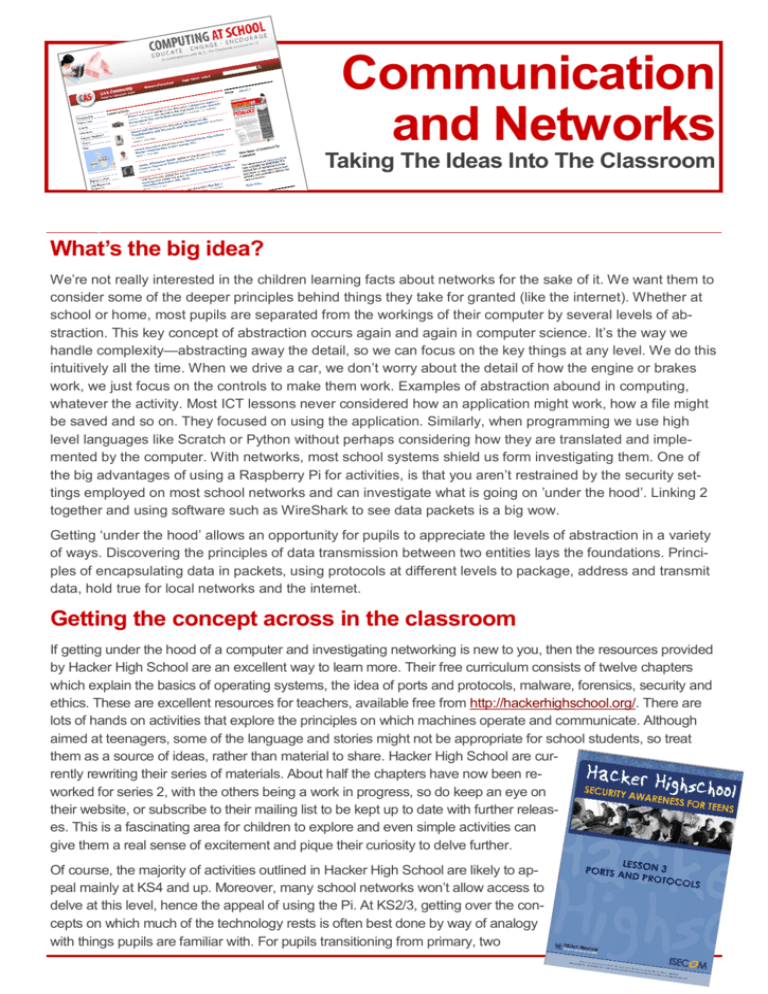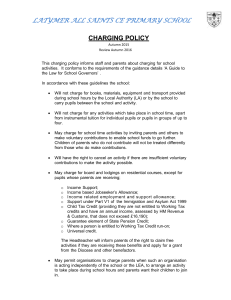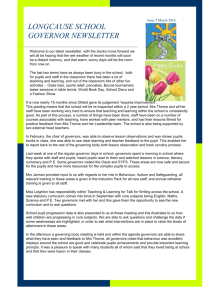Communication and Networks
advertisement

Communication and Networks Taking The Ideas Into The Classroom What’s the big idea? We’re not really interested in the children learning facts about networks for the sake of it. We want them to consider some of the deeper principles behind things they take for granted (like the internet). Whether at school or home, most pupils are separated from the workings of their computer by several levels of abstraction. This key concept of abstraction occurs again and again in computer science. It’s the way we handle complexity—abstracting away the detail, so we can focus on the key things at any level. We do this intuitively all the time. When we drive a car, we don’t worry about the detail of how the engine or brakes work, we just focus on the controls to make them work. Examples of abstraction abound in computing, whatever the activity. Most ICT lessons never considered how an application might work, how a file might be saved and so on. They focused on using the application. Similarly, when programming we use high level languages like Scratch or Python without perhaps considering how they are translated and implemented by the computer. With networks, most school systems shield us form investigating them. One of the big advantages of using a Raspberry Pi for activities, is that you aren’t restrained by the security settings employed on most school networks and can investigate what is going on ’under the hood’. Linking 2 together and using software such as WireShark to see data packets is a big wow. Getting ‘under the hood’ allows an opportunity for pupils to appreciate the levels of abstraction in a variety of ways. Discovering the principles of data transmission between two entities lays the foundations. Principles of encapsulating data in packets, using protocols at different levels to package, address and transmit data, hold true for local networks and the internet. Getting the concept across in the classroom If getting under the hood of a computer and investigating networking is new to you, then the resources provided by Hacker High School are an excellent way to learn more. Their free curriculum consists of twelve chapters which explain the basics of operating systems, the idea of ports and protocols, malware, forensics, security and ethics. These are excellent resources for teachers, available free from http://hackerhighschool.org/. There are lots of hands on activities that explore the principles on which machines operate and communicate. Although aimed at teenagers, some of the language and stories might not be appropriate for school students, so treat them as a source of ideas, rather than material to share. Hacker High School are currently rewriting their series of materials. About half the chapters have now been reworked for series 2, with the others being a work in progress, so do keep an eye on their website, or subscribe to their mailing list to be kept up to date with further releases. This is a fascinating area for children to explore and even simple activities can give them a real sense of excitement and pique their curiosity to delve further. Of course, the majority of activities outlined in Hacker High School are likely to appeal mainly at KS4 and up. Moreover, many school networks won’t allow access to delve at this level, hence the appeal of using the Pi. At KS2/3, getting over the concepts on which much of the technology rests is often best done by way of analogy with things pupils are familiar with. For pupils transitioning from primary, two games from Cisco: Peter Packet and Penny’s Search are an entertaining way to get across the key ideas of a packet switched internet. They can be downloaded or played online at http://www.cisco.com/ web/learning/netacad/packetville/hacker/games.html. Probably the best known explanation of how packets traverse the internet is the classic animation ‘Warriors Of The Net’, on YouTube or downloadable in many languages from http://warriorsofthe.net/ Students will find using Visual Trace Route websites interesting. They plot the ‘hops’ of your web request. There are many, but this one links the hops to a google map, so you can zoom in to street view if you want: http://www.yougetsignal.com/tools/visual-tracert/. A fun activity for small groups from CS Unplugged looks at the issue of routing, congestion and deadlock. Details of the ‘The Orange Game’ can be downloaded from http://csunplugged.com/routing-and-deadlock. There is a short explanatory video on the site. Computer Science for Fun has an interactive puzzle on a similar theme; http://www.cs4fn.org/algorithms/maxflow/ Some years ago, the BBC ran a four part series called The Virtual Revolution. The website supporting the series has several video clips that can be downloaded. The interview with Vint Cerf has an excellent explanation of the development of TCP/IP explained in terms of sending books on postcards that children can relate to. The interview is at http://www.bbc.co.uk/blogs/digitalrevolution/2009/11/rushes-sequencesvint-cerf-int.shtml There is a very detailed animation, that could be used as the basis of an exercise to create data packets at https://sites.google.com/site/tcpipanimation/home. Physically making up packets, by initially chopping data up, pasting on card, inserting into small envelopes, then larger envelopes gets the point across well. Instructions for a classroom simulation (approximately 8-13 students) for a web page request have been created by Gary Kacmarcik at http://cse4k12.org/internet/how-internet-works.html. They may be more suitable for older pupils. Computer Science Inside was an outreach project developed by Glasgow University. They developed a series of classroom workshops, which have direct relevance to many National Curriculum topics. You can register to download their resources at http://csi.dcs.gla.ac.uk/. Alongside the one we’ll try today, you’ll find activities to develop an understanding of data compression, predictive text and multitasking to name just a few. ‘Tablets Of Stone’ is a wonderful activity in which students develop an understanding of the considerations behind developing a communication protocol to deliver packets across the internet. We’ve included the essential material in this pack though the full resources include a supporting PowerPoint. Curriculum links This whole area is of relevance not just at Key Stages 2/3, but for GCSE and A Level courses. There is endless scope for digging deeper and deeper into the subject, exploring hierarchies of software and hardware abstraction. An appreciation of the ‘big picture’ helps pupils grasp why logic gates and Boolean algebra, for example, have relevance. This area links well with ideas of machine architecture, low level programming and data representation. The KS3 national curriculum states that children should ‘understand the hardware and software components that make up computer systems, and how they communicate with one another and with other systems.’ It goes on to state that pupils should ‘understand how instructions are stored and executed within a computer system; understand how data of various types (including text, sounds and pictures) can be represented and manipulated digitally, in the form of binary digits’. These areas are closely linked, and there are lots of resources available to help develop each area. Again, a good starting point would be to look at the other material available on CS Inside, CS Unplugged and CS For Fun. Communicating With Tablets Of Stone Computer Science Inside… In this activity pupils first analyse a communication challenge and try to identify the main problems that can occur. The problem specification tells pupils about a network of Governors living in an ancient city. The only way these Governors can communicate is by sending stone tablets using their messengers. There are three key points to the problem. 1) Governors need to communicate. Each is identified by a number, and they use their servants to carry messages. Communicating, with Tablets of Stone CS Inside... 2) Messages are sent on stone tablets. They are heavy and can only be carried one at a time. They are also small and a fixed size. Only six words can be written on each one. 3) Servants are unreliable. They stop for long breaks, can forget where they are going or escape from the city altogether. Pupils work in groups of 5 to develop the rules (protocols) needed to ensure successful communication over an unreliable network. If numbers don’t quite work, groups of 6 are fine with the extra students acting as messengers. The pupils should write down their rules for each side (sender and receiver) to follow to make sure the message gets there successfully. If not the sender must be notified. Encourage them to think about how they can deal with any problems that might arise during the communication, given what they know. Pupils should come up with rules regarding what extra control information should be sent with each message. Don’t provide answers, but if they are struggling, examples could include: Specifying a receiving Governor number (an address) A sending Governor number (a return address) Part number (to help keep messages in order) Total number of parts of the message (telling us how many messages we should expect) Acknowledgement Request (to check our message was received) Timeout before resend (if not received, re-send the message) Each group should make sure that both the sending and receiving governors write down and use the rules they have developed. The teams will then follow their own protocol in a role play activity to see which team has created the best solution. Room Setup Each pair needs to be seated around the classroom with their backs to the middle to avoid communicating. The senders and receivers should be roughly opposite each other. Each pair should have a number to identify them and scrap paper to write messages on. They should all have a copy of their agreed protocols. Each pair can operate as both a sender / or receiver. Each sending Governor is given a message to send to their receiver. Every message is the same length. Remember, no tablet can have more than six words on it. A table should be in the centre of the room with a pile of Action Cards placed face down on it. These are included in this pack. They have a range of messages on them telling the messenger what to do. The singles from each team (messengers) will gather in the middle area to start with. From there they will pick up and deliver messages from/to the Governors. Initially they should respond to their own governors, but as the activity picks up, they will need to respond to any request. Role Play Activity Each team of 5 is divided into 2 pairs and 1 single. One pair act as the sending governor, one pair become the receiving governor and the single person is one of the messengers. The sending Governor has a message they must try to get to the receiving governor. When they want to send a message, they turn round to face the middle (indicated right by the red stick man turning). This indicates the messenger is summoned by the Governors to deliver messages. Messages and any protocol information are written on paper by the sending governor (representing the tablets) and handed to the messenger. The messenger returns to the centre, with the first tablet and then selects an action card to introduce an element of unreliability. It tells them what to do with the message. They can either deliver it straight away, after a delay, not at all or they have to forget everything they have been told and see if the message tells them everything they need to know to deliver the message. The messengers should not reveal the instructions on the Action Cards to the Governors. After a while, there will be several tablets (packets) in transit (or lost). At this point it will probably dawn on the pupils that their protocols have significant defects. You may want to stop the role play after a few minutes to discuss what they have observed and allow the teams to adjust their protocols. The role play activity will test the protocols in an unreliable situation and allow the class to see which teams’ protocol was most successful. Action Cards (Several copies required) Forget what you were told verbally Only deliver the message if the tablet gives you all the information you need. Do not deliver the message at all If not, forget it and answer a new Deliver the message now Go and deliver another message BEFORE you deliver this one! Forget what you were told verbally Only deliver the message if the tablet gives you all the information you need. Do not deliver the message at all If not, forget it and answer a new Deliver the message now Go and deliver another message BEFORE you deliver this one! Sample Messages Apart from the last message, each is 12 words, but you could introduce varying sized messages. A network is a group of computers linked together to share resources Computer networking is the discipline concerned with the communication between computer systems Wide area networks for example the Internet cover a wide geographical area. Local area networks are usually limited to a room building or campus A protocol is an agreed upon format for transmitting data between devices Wireless networks are telephone or computer networks that use radio as their carrier







